Review
Transparencies and Tolerances — Four Exhibitions @ Kyotographie 2021
By Gosho Junko
2021.10.12
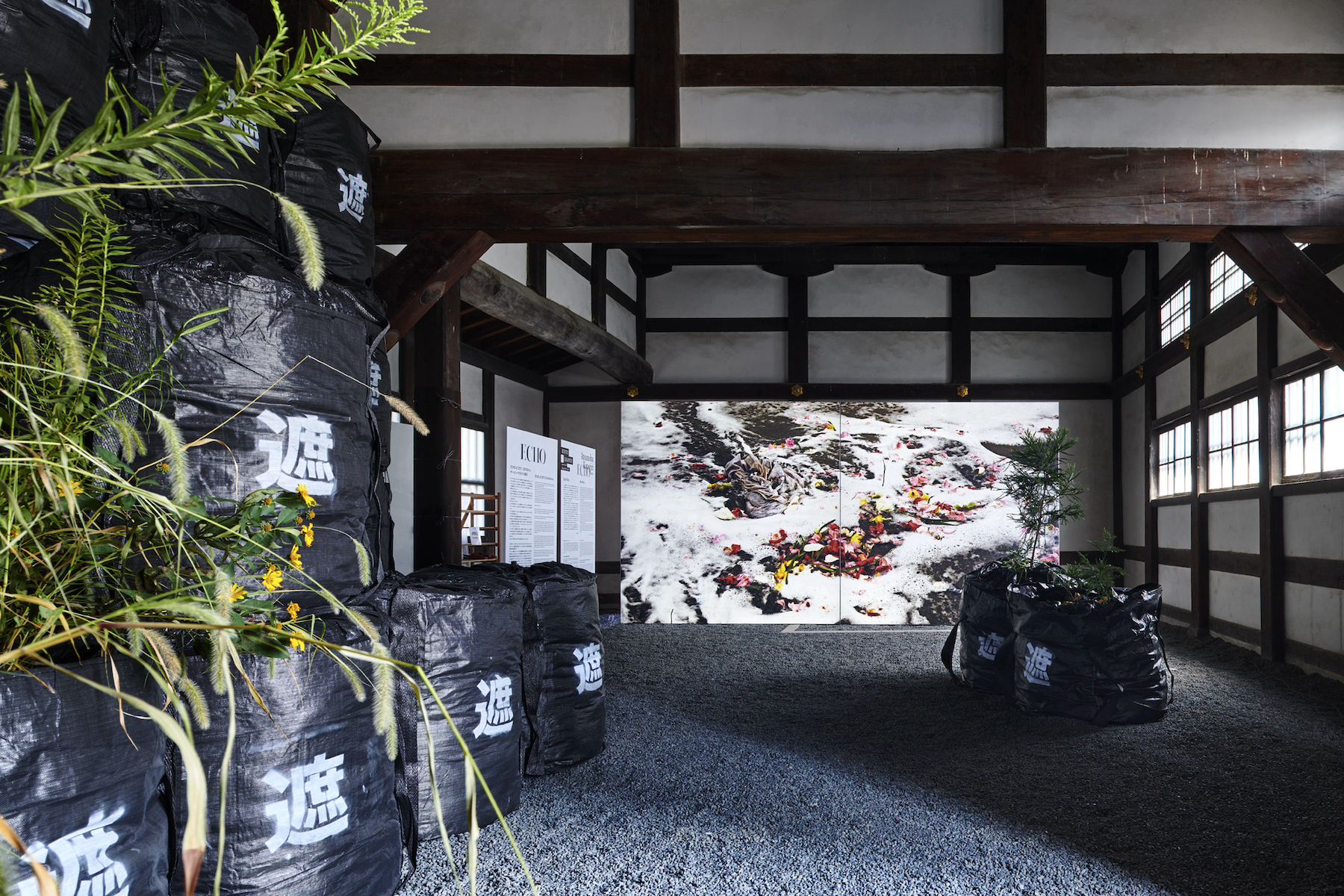
Nijo-jo Castle Ninomaru palace Daidokoro Kitchen
©︎ Takeshi Asano-KYOTOGRAPHIE 2021
KYOTOGRAPHIE 2021 turned into a journey through gradations of transparency.
Allow me to write about that journey in order from low to high transparency. Transparency 0: Katagiri Atsunobu “Sacrifice”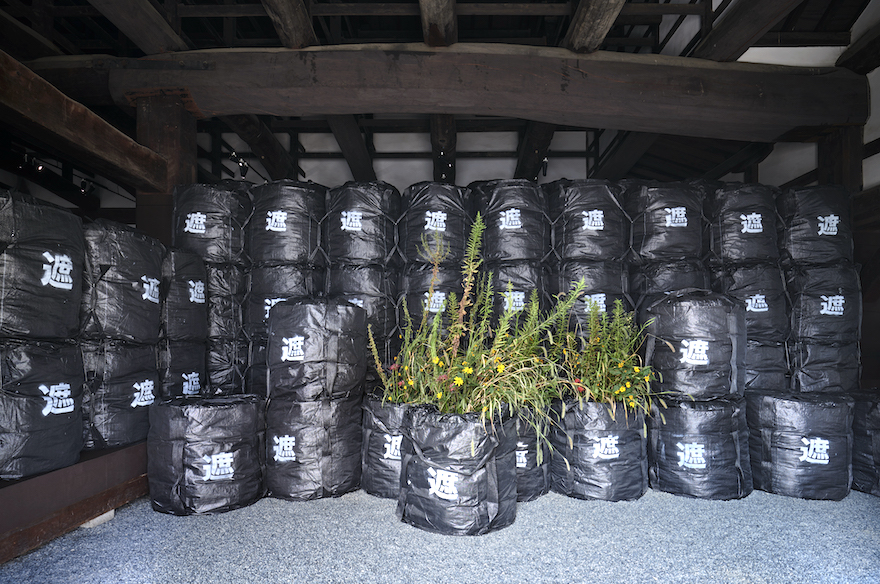
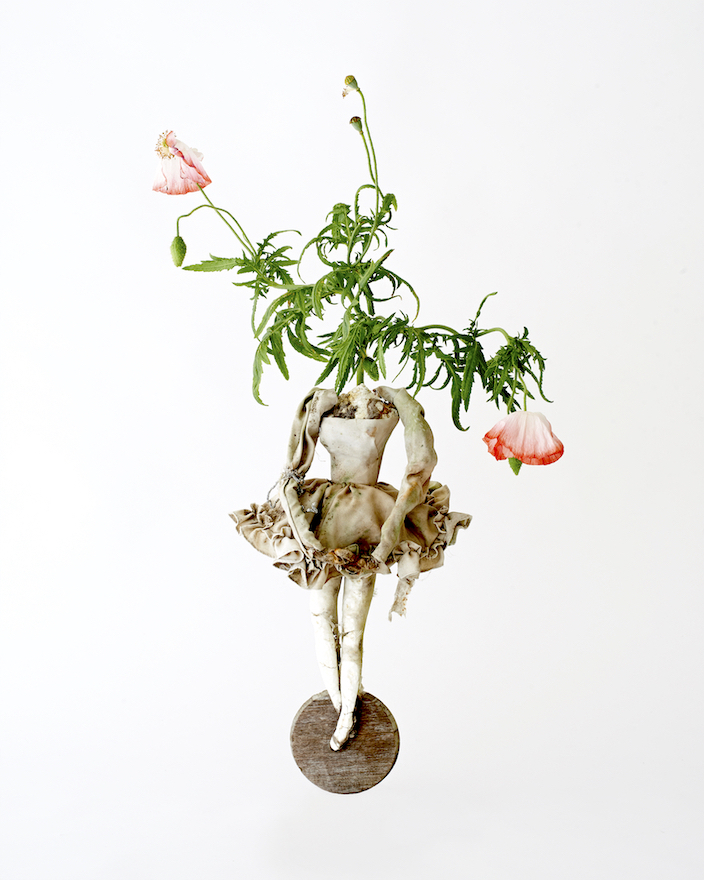 Making my way along the asphalt and across the gravel, on entering the Nijo-jo Castle Ninomaru Palace Daidokoro Kitchen I found the path blocked by soil. Staring straight at me was a tall stack of large black industrial bags, concealing what lay behind. Transparency level zero. They say the stone blocks of the Pyramids measure about 90 to 150cm in height, but are these bags squatting in the castle building materials, waste, or black boxes? Arranged in this tatami room supported by sturdy beams the color of caramel cooked for 400 years are scenes of destruction transplanted there from ten years before. Broken poles, abandoned vehicles, a hallway still showered in dirt, and through them all flowers, flowers, flowers. For this writer at least, flower-arranging was previously a vulgar, formulaic sort of beauty, a diversion for my grandmother and mother and neighborhood housewives. But here, the floral forms infiltrating even the home, twisting their way in, bring an unexpected balance to a broken everyday, taking that destruction to a different level. Of particular note was a photo of drooping poppies arranged in a white porcelain dancing girl figurine missing her head. More important perhaps than the absence of a head is the distortion of the legs and base, which goes beyond the eccentric matching of different objects to disrupt the angle of the viewer. Here was the warped beauty of the inseparably conjoined.
Making my way along the asphalt and across the gravel, on entering the Nijo-jo Castle Ninomaru Palace Daidokoro Kitchen I found the path blocked by soil. Staring straight at me was a tall stack of large black industrial bags, concealing what lay behind. Transparency level zero. They say the stone blocks of the Pyramids measure about 90 to 150cm in height, but are these bags squatting in the castle building materials, waste, or black boxes? Arranged in this tatami room supported by sturdy beams the color of caramel cooked for 400 years are scenes of destruction transplanted there from ten years before. Broken poles, abandoned vehicles, a hallway still showered in dirt, and through them all flowers, flowers, flowers. For this writer at least, flower-arranging was previously a vulgar, formulaic sort of beauty, a diversion for my grandmother and mother and neighborhood housewives. But here, the floral forms infiltrating even the home, twisting their way in, bring an unexpected balance to a broken everyday, taking that destruction to a different level. Of particular note was a photo of drooping poppies arranged in a white porcelain dancing girl figurine missing her head. More important perhaps than the absence of a head is the distortion of the legs and base, which goes beyond the eccentric matching of different objects to disrupt the angle of the viewer. Here was the warped beauty of the inseparably conjoined.
Transparency 1: Obara Kazuma “Fill in the Blanks”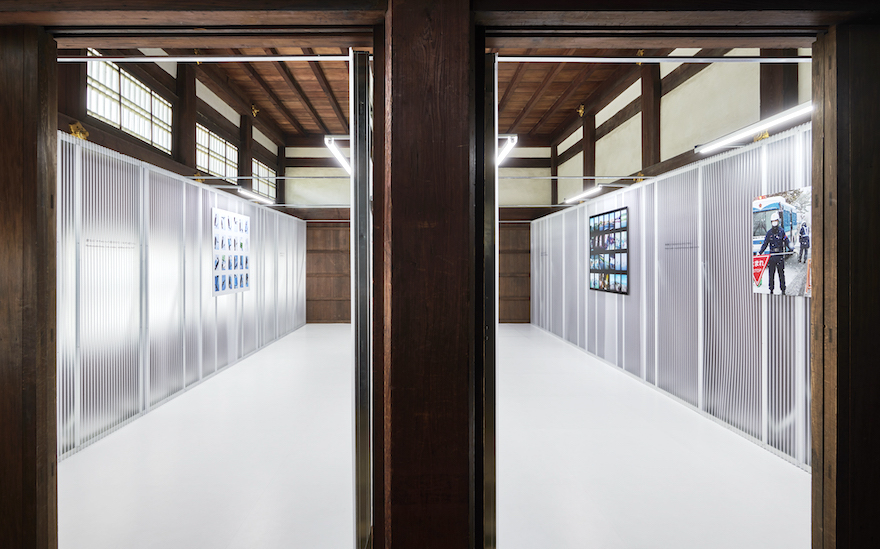
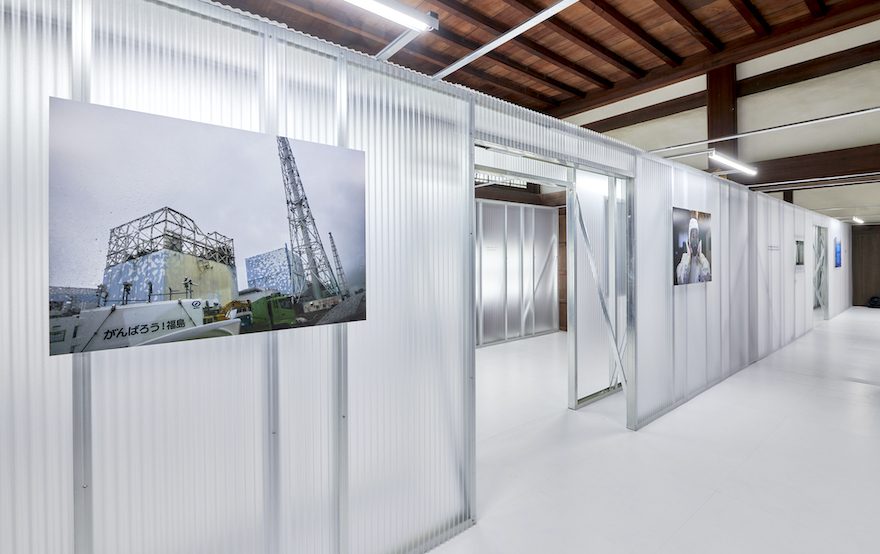 Inside the Nijo-jo Castle is a space with a peculiarly knocked-up-cheaply look. The walls are enclosed in semitransparent corrugated sheeting resembling galvanized iron, and glow with the chilly glare of fluorescent lights in a convenience store. Or perhaps the bleached white of a hospital room, or a dreary, dispiriting factory. Photos capturing TEPCO’s Fukushima power station, and COVID-19 wards, show semitransparent people. Both nuclear plant workers and medical staff are dressed in semitransparent protective gear. Both radioactive matter and virus are invisible to the eye. But they’re there. These photos show the irony of semitransparent gear worn by people who labor in the face of a danger being the very thing blurring the reality of that danger’s presence. Transparency level one. Semi-see-through PPE is safety camouflage for the landscape, and turns those performing dangerous tasks into phantoms. Voices ring out as if slowly peeling off that garb. Yet the characters printed on the corrugated sheeting are faint, undulate back and forth, and cannot be read easily. Perhaps the form of voices intertwining people’s endurance and acceptance is a tolerance, a permissible deviation that modern society accepts, or is indifferent to.
Inside the Nijo-jo Castle is a space with a peculiarly knocked-up-cheaply look. The walls are enclosed in semitransparent corrugated sheeting resembling galvanized iron, and glow with the chilly glare of fluorescent lights in a convenience store. Or perhaps the bleached white of a hospital room, or a dreary, dispiriting factory. Photos capturing TEPCO’s Fukushima power station, and COVID-19 wards, show semitransparent people. Both nuclear plant workers and medical staff are dressed in semitransparent protective gear. Both radioactive matter and virus are invisible to the eye. But they’re there. These photos show the irony of semitransparent gear worn by people who labor in the face of a danger being the very thing blurring the reality of that danger’s presence. Transparency level one. Semi-see-through PPE is safety camouflage for the landscape, and turns those performing dangerous tasks into phantoms. Voices ring out as if slowly peeling off that garb. Yet the characters printed on the corrugated sheeting are faint, undulate back and forth, and cannot be read easily. Perhaps the form of voices intertwining people’s endurance and acceptance is a tolerance, a permissible deviation that modern society accepts, or is indifferent to.
Transparency 2: Liang Yingfei “Beneath the Scars”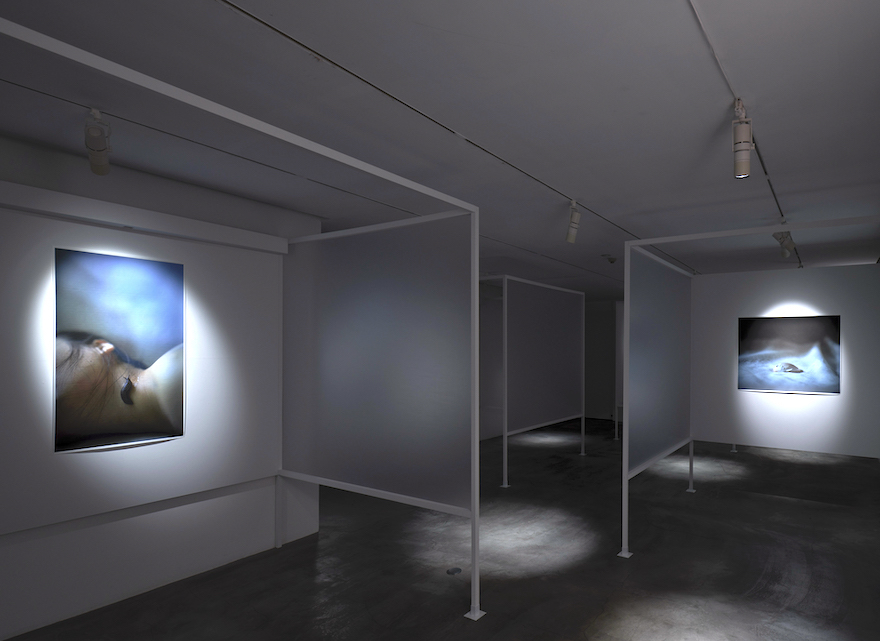
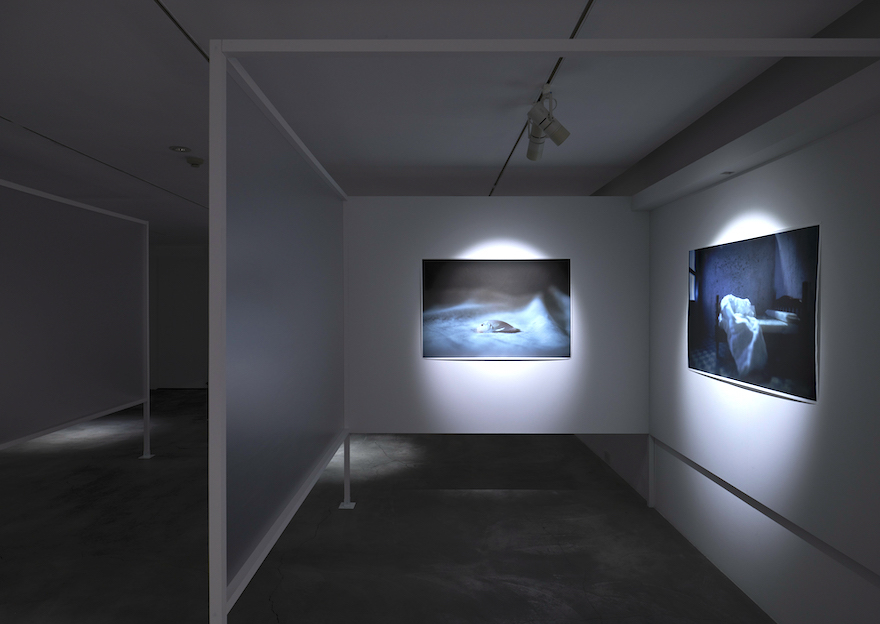 Tackling the experience of victims of sexual violence, photos displayed with accompanying sound. The display consists of photographs on the wall that seem to crystallize memories, with the voice relating the victim’s experience growing clearer as one approaches the image. Yet the images feel grainy and banal, and the voices unaffected; the narrators merely telling what has happened, with little inflection. Grasping where things were occurring from, what was abuse and what was not, at what point the damage could have been averted if they had turned back, and so on, requires considerable concentration on the part of the spectator. That is to say, here we have memories of abuse; the state of the memories of the abuse, memories of the one subjected to it, memories still lingering with the one subjected to it. The presence of film resembling frosted glass, each memory partitioned off, dominates the exhibition and serves to indicate the social status of survivors of sexual violence. Like the pixelation of faces in news reports, a screen surrounding the plaintiff in court, a curtain in a hospital room, my own room, a veil I place myself over my memories… The concealing of violence, the hiding of personal information, the preservation of psychological safety, are closely entwined. Transparency level two. Frosted-glass-like film that shows the blurred forms of figures behind frosted glass, but that shows without question that someone is behind there. Perhaps the artist and exhibition designer offered this as photographs.
Tackling the experience of victims of sexual violence, photos displayed with accompanying sound. The display consists of photographs on the wall that seem to crystallize memories, with the voice relating the victim’s experience growing clearer as one approaches the image. Yet the images feel grainy and banal, and the voices unaffected; the narrators merely telling what has happened, with little inflection. Grasping where things were occurring from, what was abuse and what was not, at what point the damage could have been averted if they had turned back, and so on, requires considerable concentration on the part of the spectator. That is to say, here we have memories of abuse; the state of the memories of the abuse, memories of the one subjected to it, memories still lingering with the one subjected to it. The presence of film resembling frosted glass, each memory partitioned off, dominates the exhibition and serves to indicate the social status of survivors of sexual violence. Like the pixelation of faces in news reports, a screen surrounding the plaintiff in court, a curtain in a hospital room, my own room, a veil I place myself over my memories… The concealing of violence, the hiding of personal information, the preservation of psychological safety, are closely entwined. Transparency level two. Frosted-glass-like film that shows the blurred forms of figures behind frosted glass, but that shows without question that someone is behind there. Perhaps the artist and exhibition designer offered this as photographs.
Transparency 3: RongRong&inri “Jifei Kyoto”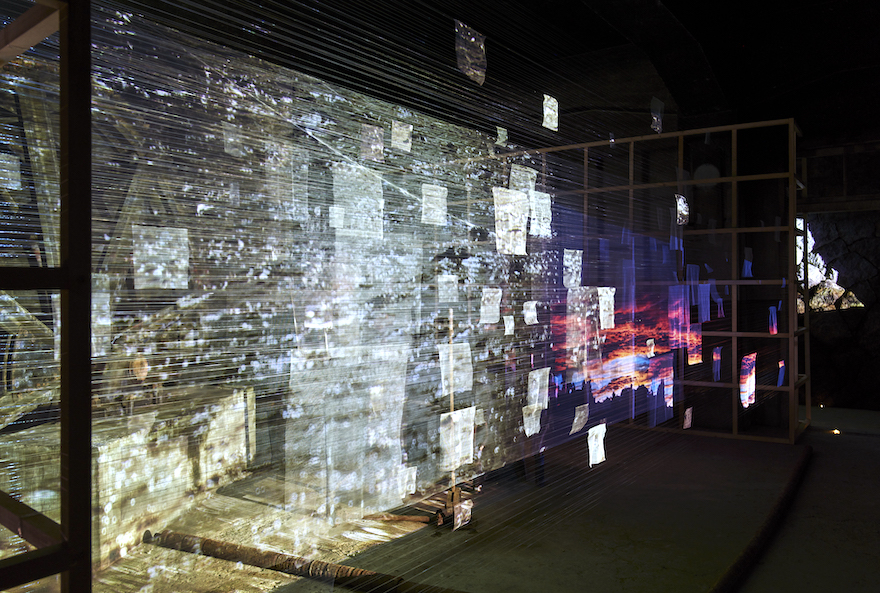
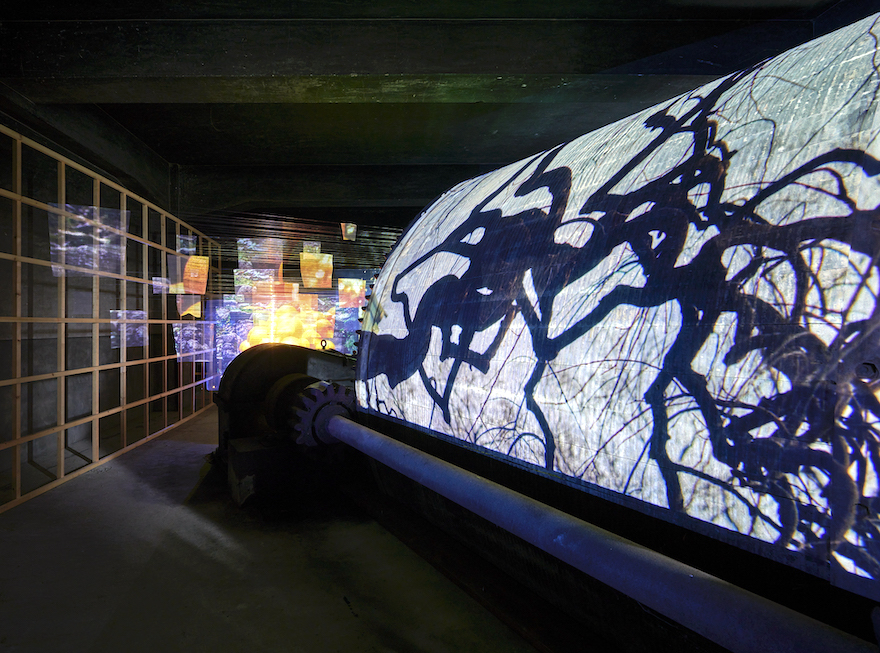 As we climb the gentle slope and pass through the gate, my companion remarks, “They say the people of Kyoto built this because they missed having the emperor around.” Standing on the former site of the Keage Incline, construction of which began in 1887 and which saw service from 1891 to 1948, we bathe in the roar of the torrent of water beside the railway. Walking on, before entering a shed at the end of the path we are enjoined to watch our step. Inside is dark. I stumble slightly. Peering into the gloom I see wooden latticework frames on either side, with fishing line strung between, hanging from it mesh fabric, and crouching in a corner of the darkness, as if bating its breath, a large cylindrical winch three or four meters across. The numerous tiny screens suspended close by and far away resemble strips of light, yet being made of mesh do not receive the image as a cohesive whole, but split into pixels. The afterimage that imprints on the eye is conversely that of the mesh, and with light projecting all over my skin, I walk on. On arriving at the very back of the shed, I am surprised to find a tiny, brightly lit room. There, light is captured from wired glass, and the afterimage of a moment before is transferred to this glass, to be forgotten. Here, disintegrated particles are regathered and transformed into an even more delicately condensed monochrome image. Lingering between the gelatin silver by the window and the washi paper on the wall, I am witness to the genesis of photography. Walking once again into the darkness and about to end my circuit of the shed, I come upon a section where the floorboards have been removed and replaced by tempered glass. The water of the canal is visible beneath me. The cumulative light from the water collects in the shed from the glass floor, and looking up I see images quivering playfully on the ceiling, and a prism projected on the end of the winch. A winch resembling a giant reel that has lost its film, the glass floor of the drum plant, and a tiny hole in a dark room: the moment I realize that this box itself is a camera obscura, the prism vanishes. Transparency level three.
As we climb the gentle slope and pass through the gate, my companion remarks, “They say the people of Kyoto built this because they missed having the emperor around.” Standing on the former site of the Keage Incline, construction of which began in 1887 and which saw service from 1891 to 1948, we bathe in the roar of the torrent of water beside the railway. Walking on, before entering a shed at the end of the path we are enjoined to watch our step. Inside is dark. I stumble slightly. Peering into the gloom I see wooden latticework frames on either side, with fishing line strung between, hanging from it mesh fabric, and crouching in a corner of the darkness, as if bating its breath, a large cylindrical winch three or four meters across. The numerous tiny screens suspended close by and far away resemble strips of light, yet being made of mesh do not receive the image as a cohesive whole, but split into pixels. The afterimage that imprints on the eye is conversely that of the mesh, and with light projecting all over my skin, I walk on. On arriving at the very back of the shed, I am surprised to find a tiny, brightly lit room. There, light is captured from wired glass, and the afterimage of a moment before is transferred to this glass, to be forgotten. Here, disintegrated particles are regathered and transformed into an even more delicately condensed monochrome image. Lingering between the gelatin silver by the window and the washi paper on the wall, I am witness to the genesis of photography. Walking once again into the darkness and about to end my circuit of the shed, I come upon a section where the floorboards have been removed and replaced by tempered glass. The water of the canal is visible beneath me. The cumulative light from the water collects in the shed from the glass floor, and looking up I see images quivering playfully on the ceiling, and a prism projected on the end of the winch. A winch resembling a giant reel that has lost its film, the glass floor of the drum plant, and a tiny hole in a dark room: the moment I realize that this box itself is a camera obscura, the prism vanishes. Transparency level three.
Gosho Junko
Writer. Her latest book, Kusuri wo kuu onnatachi (Women who eat drugs), was published in 2021 by Kawade Shobo Shinsha.
※KYOTOGRAPHIE 2021 is being held at various locations throughout Kyoto, September 18 to October 17, 2021.
Allow me to write about that journey in order from low to high transparency. Transparency 0: Katagiri Atsunobu “Sacrifice”

Atsunobu Katagiri “Sacrifice”
in Nijo-jo Castle Ninomaru palace Daidokoro Kitchen
©︎ Takeshi Asano-KYOTOGRAPHIE 2021

Atsunobu Katagiri “Sacrifice,” 2014
© Atsunobu Katagiri
Transparency 1: Obara Kazuma “Fill in the Blanks”


Kazuma Obara “Fill In the Blanks”
Nijo-jo Castle Ninomaru Palace Daidokoro Kitchen and Okiyodokoro Kitchen
©︎ Takeshi Asano-KYOTOGRAPHIE 2021
Transparency 2: Liang Yingfei “Beneath the Scars”


Yingfei Liang “Beneath the Scars”
Sfera
©︎ Takeshi Asano-KYOTOGRAPHIE 2021
Transparency 3: RongRong&inri “Jifei Kyoto”


RongRong&inri “Jifei Kyoto”
Outdoor Space of Lake Biwa Canal Museum
©︎ Takeshi Asano-KYOTOGRAPHIE 2021
Gosho Junko
Writer. Her latest book, Kusuri wo kuu onnatachi (Women who eat drugs), was published in 2021 by Kawade Shobo Shinsha.
※KYOTOGRAPHIE 2021 is being held at various locations throughout Kyoto, September 18 to October 17, 2021.